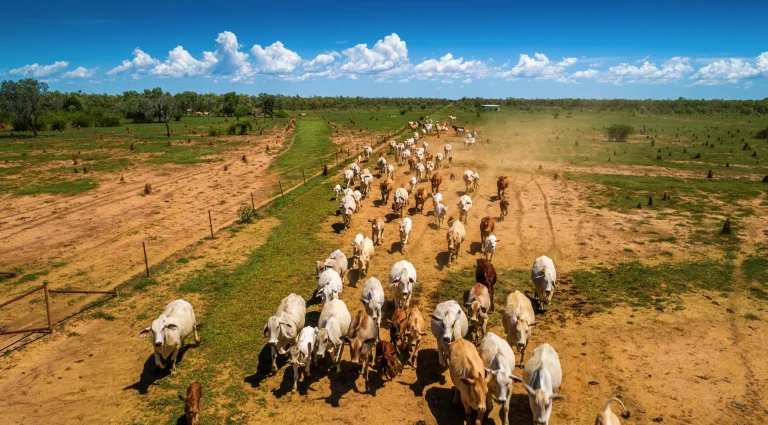Guidelines for Investing in the Australian Livestock Industry
Australia’s livestock industry represents one of the world’s most significant agricultural sectors, offering substantial opportunities for strategic investors seeking exposure to agricultural assets. Understanding the guidelines for investing in the Australian livestock industry requires comprehensive knowledge of market dynamics, regulatory frameworks, and operational considerations that define successful livestock operations. These guidelines for investing in the Australian livestock industry encompass everything from property selection and due diligence to long-term portfolio management and risk mitigation strategies.
The Australian livestock sector continues to attract both domestic and international investors due to its robust export markets, technological innovation, and established infrastructure. At Agribusiness Horizons, we specialize in facilitating livestock property transactions and providing strategic guidance to investors navigating this complex but rewarding sector. Our expertise in agricultural property transactions, combined with deep market intelligence, positions us to help investors identify premium livestock opportunities that align with their investment objectives and risk profiles.
Understanding the Australian Livestock Market Landscape
Australia’s livestock industry spans diverse geographic regions, each offering unique advantages for different types of livestock operations. The sector encompasses cattle grazing, sheep farming, intensive feedlot operations, and specialized breeding programs across varied climatic zones from tropical northern regions to temperate southern areas. This diversity creates multiple investment pathways, each with distinct characteristics regarding land requirements, infrastructure needs, and market positioning.
The regulatory environment governing livestock operations involves multiple layers of oversight, including animal welfare standards, environmental compliance, and biosecurity protocols. State and federal regulations establish minimum standards for animal husbandry, land management practices, and export certification requirements. Understanding these regulatory frameworks is essential for investors seeking to acquire livestock properties, as compliance costs and operational restrictions can significantly impact profitability and long-term viability.
Market access remains a critical consideration for livestock investors, with Australia maintaining strong trading relationships across Asia-Pacific regions and emerging markets. Export demand patterns influence domestic pricing structures, creating opportunities for investors who understand seasonal variations and international trade dynamics. Properties with superior logistics access, established supply chain relationships, and proven export certification capabilities typically command premium valuations in the marketplace.
Strategic Property Selection and Due Diligence
Successful livestock investment begins with comprehensive property evaluation that extends beyond basic land assessments to include carrying capacity analysis, infrastructure condition, and operational efficiency metrics. Carrying capacity calculations must account for seasonal variations, drought resilience, and sustainable stocking rates that maintain long-term productivity without compromising environmental integrity. Properties with diverse pasture systems, reliable water sources, and flexible infrastructure configurations offer superior risk-adjusted returns compared to single-purpose operations.
Infrastructure assessment encompasses livestock handling facilities, fencing systems, water distribution networks, and accommodation facilities that support operational efficiency. Modern livestock operations require sophisticated handling systems that minimize stress on animals while maximizing labor productivity. Properties with recently upgraded infrastructure, including cattle yards, sheep handling facilities, and feed storage systems, typically offer immediate operational advantages and reduced capital expenditure requirements for new owners.
Water security represents perhaps the most critical factor in livestock property evaluation, particularly given Australia’s variable rainfall patterns and increasing climate volatility. Properties with secure water rights, multiple water sources, and efficient distribution systems provide essential operational stability. Due diligence must include comprehensive water audits, rights verification, and sustainability assessments that evaluate long-term water availability under various climate scenarios.
Financial Analysis and Investment Structuring
Livestock property investments require sophisticated financial modeling that accounts for operational cash flows, capital appreciation potential, and risk-adjusted returns across multiple time horizons. Revenue projections must incorporate livestock price volatility, seasonal production variations, and operational cost fluctuations that characterize agricultural enterprises. Successful investors develop comprehensive financial models that stress-test performance under various market conditions and operational scenarios.
Capital requirements for livestock operations extend beyond initial property acquisition to include working capital for livestock purchases, operational expenses, and infrastructure maintenance. Investors must plan for significant upfront investments in livestock inventory, which can represent substantial capital commitments depending on operation scale and livestock types. Financing structures should accommodate seasonal cash flow patterns and provide flexibility for operational adjustments based on market conditions.
Tax considerations play a crucial role in livestock investment structuring, with various concessions available for primary production activities, capital improvements, and environmental stewardship programs. Professional tax advice is essential for optimizing investment structures and maximizing after-tax returns. Investors should also consider succession planning implications, particularly for family office investments seeking multi-generational wealth preservation through agricultural assets.
Risk Management and Mitigation Strategies
Livestock investments face multiple risk categories that require comprehensive management strategies to protect capital and optimize returns. Market risks include commodity price volatility, currency fluctuations for export-oriented operations, and demand variations across different market segments. Operational risks encompass animal health issues, weather-related challenges, and labor availability concerns that can significantly impact productivity and profitability.
- Diversification strategies across multiple livestock types, geographic regions, and market segments to reduce concentration risk
- Insurance coverage including livestock mortality, business interruption, and weather-related losses to protect against catastrophic events
- Biosecurity protocols to prevent disease outbreaks that could devastate livestock populations and compromise market access
- Financial hedging using futures markets and forward contracts to manage price volatility and cash flow uncertainty
Environmental risks require particular attention given increasing regulatory scrutiny and community expectations regarding sustainable farming practices. Climate change impacts, including extreme weather events and shifting rainfall patterns, necessitate adaptive management strategies and resilient infrastructure investments. Properties with strong environmental credentials and demonstrated sustainability practices often command premium valuations and attract ESG-focused investors.
Operational Excellence and Management Considerations
Successful livestock operations require skilled management teams with expertise in animal husbandry, pasture management, and business operations. Investors must evaluate existing management capabilities and develop strategies for attracting and retaining qualified personnel. Many successful livestock investments involve partnerships with experienced operators who provide day-to-day management expertise while investors provide capital and strategic oversight.
Technology adoption continues transforming livestock operations, with innovations in animal monitoring, pasture management, and supply chain integration offering competitive advantages. Properties equipped with modern technology systems, including electronic identification systems, precision agriculture tools, and data management platforms, typically demonstrate superior operational efficiency and decision-making capabilities. Investors should evaluate technology infrastructure and plan for ongoing upgrades to maintain competitive positioning.
Pasture management represents a critical operational component that directly impacts carrying capacity, animal performance, and environmental sustainability. Effective pasture systems require ongoing investment in soil health, species diversity, and rotational grazing practices that optimize productivity while maintaining ecological integrity. Properties with well-managed pasture systems demonstrate superior long-term sustainability and resilience compared to extensively grazed operations.
Market Timing and Investment Opportunities
Understanding market cycles and timing considerations can significantly impact livestock investment returns. Commodity price cycles, land value fluctuations, and interest rate environments all influence optimal investment timing. Experienced investors monitor multiple market indicators to identify acquisition opportunities during favorable market conditions while avoiding peak pricing periods that may limit future returns.
Seasonal factors also influence livestock investment opportunities, with different times of year offering advantages for property acquisition, livestock purchasing, and operational transitions. Understanding seasonal patterns in livestock markets, feed costs, and property availability helps investors optimize transaction timing and operational planning. Properties marketed during optimal seasons typically attract broader buyer interest and achieve premium pricing outcomes.
Regional market dynamics create opportunities for investors who understand local conditions, infrastructure developments, and regulatory changes that impact property values. Areas experiencing infrastructure improvements, processing facility expansions, or export market developments often present attractive investment opportunities before broader market recognition drives price appreciation.
Livestock Investment Comparison Analysis
| Investment Type | Capital Requirements | Management Intensity | Risk Profile | Return Potential |
|---|---|---|---|---|
| Cattle Grazing | Moderate to High | Moderate | Moderate | Steady appreciation |
| Sheep Operations | Moderate | High | Moderate to High | Variable returns |
| Intensive Feedlots | High | Very High | High | Higher potential returns |
| Breeding Programs | High | Very High | High | Premium returns |
Agribusiness Horizons’ Livestock Investment Expertise
At Agribusiness Horizons, we bring specialized expertise to livestock property transactions, combining deep agricultural knowledge with sophisticated financial analysis capabilities. Our team understands the unique characteristics of different livestock operations, from extensive grazing enterprises to intensive production systems, enabling us to provide targeted guidance for investors seeking exposure to this dynamic sector.
Our comprehensive approach to livestock investment advisory includes property identification, due diligence coordination, financial modeling, and transaction management services tailored to each client’s specific investment objectives. We leverage our extensive network of industry contacts, including livestock operators, veterinarians, and agricultural consultants, to provide clients with access to off-market opportunities and expert insights that enhance investment decision-making.
The guidelines for investing in the Australian livestock industry require navigation of complex regulatory, operational, and financial considerations that benefit from professional expertise. Our team’s experience in livestock property transactions, combined with our understanding of market dynamics and investment structuring, positions us to help clients achieve their livestock investment objectives while managing associated risks effectively.
Future Trends and Emerging Opportunities
The Australian livestock industry continues evolving with technological innovations, changing consumer preferences, and environmental considerations creating new investment opportunities. Precision agriculture technologies, including satellite monitoring, soil sensors, and livestock tracking systems, are enhancing operational efficiency and decision-making capabilities. Properties positioned to adopt these technologies offer potential competitive advantages and superior long-term returns.
Sustainability initiatives and carbon offset programs present emerging revenue opportunities for livestock operations that implement environmentally beneficial practices. Properties with strong environmental credentials and potential for carbon sequestration may qualify for additional income streams through carbon credit programs and sustainability certifications. These opportunities align with growing ESG investment trends and may command premium valuations from environmentally conscious investors.
Consumer demand for premium, ethically produced livestock products continues growing, creating opportunities for operations that can demonstrate superior animal welfare standards and sustainable production practices. Properties capable of meeting premium market requirements through certified organic production, grass-fed systems, or specialty breeding programs may achieve higher per-unit returns and reduced commodity price exposure.
Conclusion
The guidelines for investing in the Australian livestock industry encompass a comprehensive framework that successful investors must understand to navigate this complex but rewarding sector effectively. From initial property selection and due diligence through operational management and risk mitigation, each aspect requires careful consideration and professional expertise to optimize investment outcomes.
Success in livestock investment requires understanding market dynamics, regulatory requirements, operational considerations, and financial structuring that characterize this specialized agricultural sector. The guidelines for investing in the Australian livestock industry provide a roadmap for investors seeking to capitalize on opportunities within this fundamental component of Australia’s agricultural economy.
As you consider livestock investment opportunities, several thought-provoking questions emerge: How will evolving consumer preferences for sustainable and ethically produced livestock products impact your investment strategy? What role should technology adoption play in your property selection criteria? How can you structure your livestock investments to capture both current income and long-term capital appreciation while managing the inherent risks of agricultural operations?
Contact Agribusiness Horizons today to discuss how our specialized expertise in livestock property transactions can help you navigate the complexities of investing in Australia’s dynamic livestock industry. Our team stands ready to provide the professional guidance and market insights necessary to identify and secure premium livestock investment opportunities that align with your strategic objectives.



